France has wine, Germany has beer, and Puerto Rico has rum.
Puerto Rico is the rum capital of the world. I found that out as soon as the plane touched down in San Juan airport, thanks to a sign that said “Welcome to Puerto Rico: rum capital of the world.”
It’s also the birthplace of one of my favourite cocktails: the Piña Colada. So when visiting the country earlier this month, of course I had to have a Piña Colada (or two), washed back with one of the Caribbean country’s other favourites, a Cuba Libre. I also had to visit Bacardí headquarters – it would have been rude not to, especially as they were only a five minute drive from my hotel in Levittown.
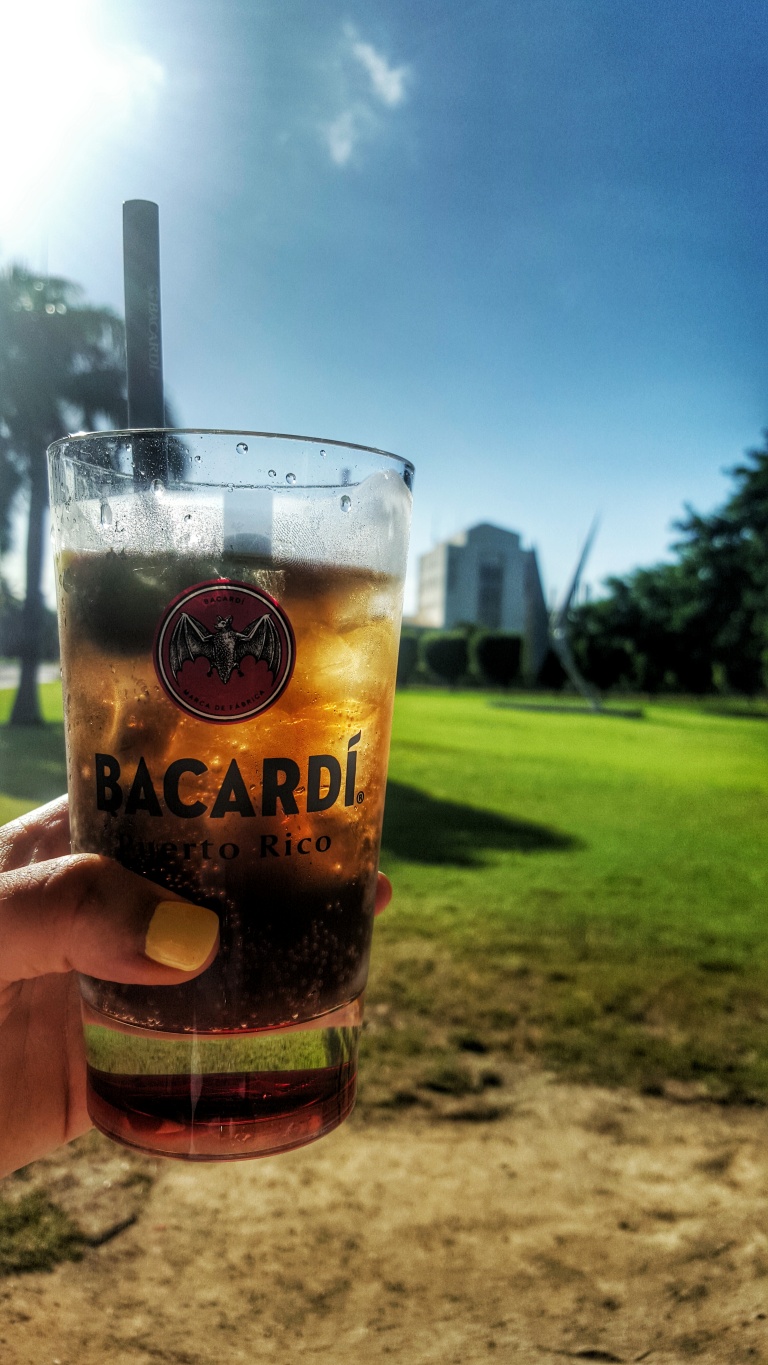
The Bacardí distillery tour is a must-do if you’re in Puerto Rico, even if you’re not a massive fan of rum. There is a lot to see, do and taste, and muchos to learn about the company that produces the world’s most acclaimed rum.
I opted for the historical tour, which lasts about an hour and a half, and gives you a free welcome cocktail (in a souvenir plastic tumbler) and a guided tour of Casa Bacardí. I also got a pair of very snazzy Bacardí sunglasses, as the hotel gave me a coupon before I set out that morning (it’s definitely worth checking with your hotel if they have these coupons – there were a range of free gifts available, depending on the coupon you had).
So, apart from the fact that Puerto Rico is the rum capital of the world, what did I learn about the drink and the Bacardí company while I was on the tour? Well I was surprised to discover that the rum that’s so proudly Puerto Rican (“aged, filtered and blended in Puerto Rico” reads every bottle), was actually created in Cuba, by a Spaniard. Here’s how the story goes:
1. Bacardí recently celebrated its 154th birthday…
Ok, so you know this one already, but Bacardí rum was actually born in Cuba, not Puerto Rico. Following a long, hefty labour, that renowned taste of the Caribbean began life on 4 February 1862. It was a birth that changed the world of rum-making.
Founder Don Facundo Bacardí Massó immigrated from Spain to Santiago de Cuba in 1830, where he set himself up as a wine merchant. Within a few years though, heady by the heat of Havana, he began experimenting with the distillation of rum.
Working with close family members, years of trial and error helped Facundo Bacardí Massó make a breakthrough that revolutionised the manufacture of rum, and eventually transformed it from a local Caribbean bevvy into an internationally consumed spirit.
The new-and-improved rum was welcomed by the Cuban locals, who until then had known only the fiery local tipple “Aguardiente” (which I drunk plenty of in Colombia last year – trust me, it’s a killer). They loved the taste of Bacardí’s smooth, mixable rum, which was branded with an elegant and intriguing black bat on the label. The Bacardí business boomed, and the family profited.
In 1920, Prohibition saw the company and Cuba benefit from an influx of Americans to the island, all looking for a stiff drink and a good party. With Cuba’s thriving economy and cosmopolitan culture, hazy Havana nights became a “thing”. But life wasn’t always rosy. The Bacardí family faced major adversities: a fire, earthquakes, disease and financial distress. They persevered however, and ended up moving the distillery to Puerto Rico in 1936.
Relations between the company and Cuba soured in 1960, when the Bacardí operations were nationalised by the government, following the Communist takeover. And Facundo Bacardí Massó and his family were exiled by Fidel Castro. But by that point Bacardí had already set up shop in five other countries: the US, Mexico, Puerto Rico, Spain and The Bahamas. The company continued to produce rum, bouncing back from yet more adversity.
Going from triumph to triumph, Bacardí is now the world’s most awarded rum, selling in over 160 countries around the globe.

2. Bacardí owns the largest rum distillery in the world…
The Bacardí facility in Cataño, Puerto Rico, is the largest premium rum distillery in the world, covering land of 127 acres. It opened in 1936, and in 1958 Puerto Rico’s governor christened it the “Cathedral of Rum.”
Here it is in all it’s glory, isn’t it a beaut?
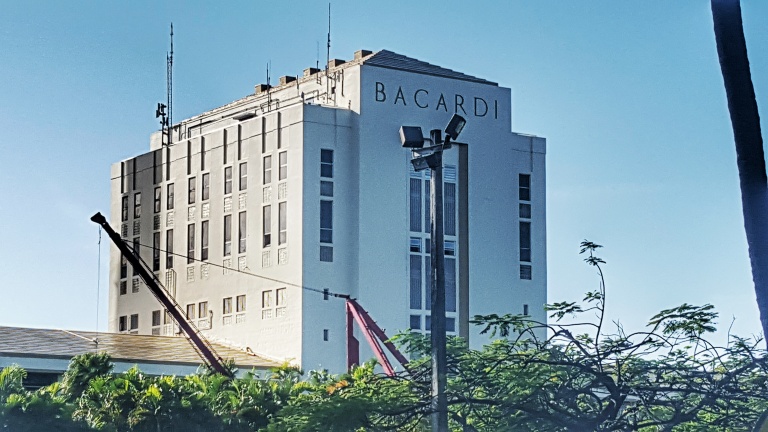
Over 85% of the world’s Bacardí is made in the distillery, and 100% of the Bacardí rum sold in the US is produced here. The distillery itself is huge – 20 fermentation tanks, spanning 5 floors, each holding about 200,000 litres of liquid to be distilled in copper, cast-iron and stainless-steel columns. Later, the rum ages in barrels – a whopping 460,000 of them at any given time.
“We produce over 100,000 litres of rum every 24 hours,” said the tour guide. Impressive.
3. But Bacardí rum is not bottled at the distillery…
The tour guide explained that despite the size of its operations at Cataño, Bacardí no longer bottles the rum it produces at the Puerto Rico distillery on the island. Instead, the Puerto Rico rum is shipped in steel containers to Jacksonville, Florida, where it’s bottled and labelled.
The Bacardi bottling plant in Florida produces 45,000 cases of rum every day. That’s a lot of Piña Coladas.
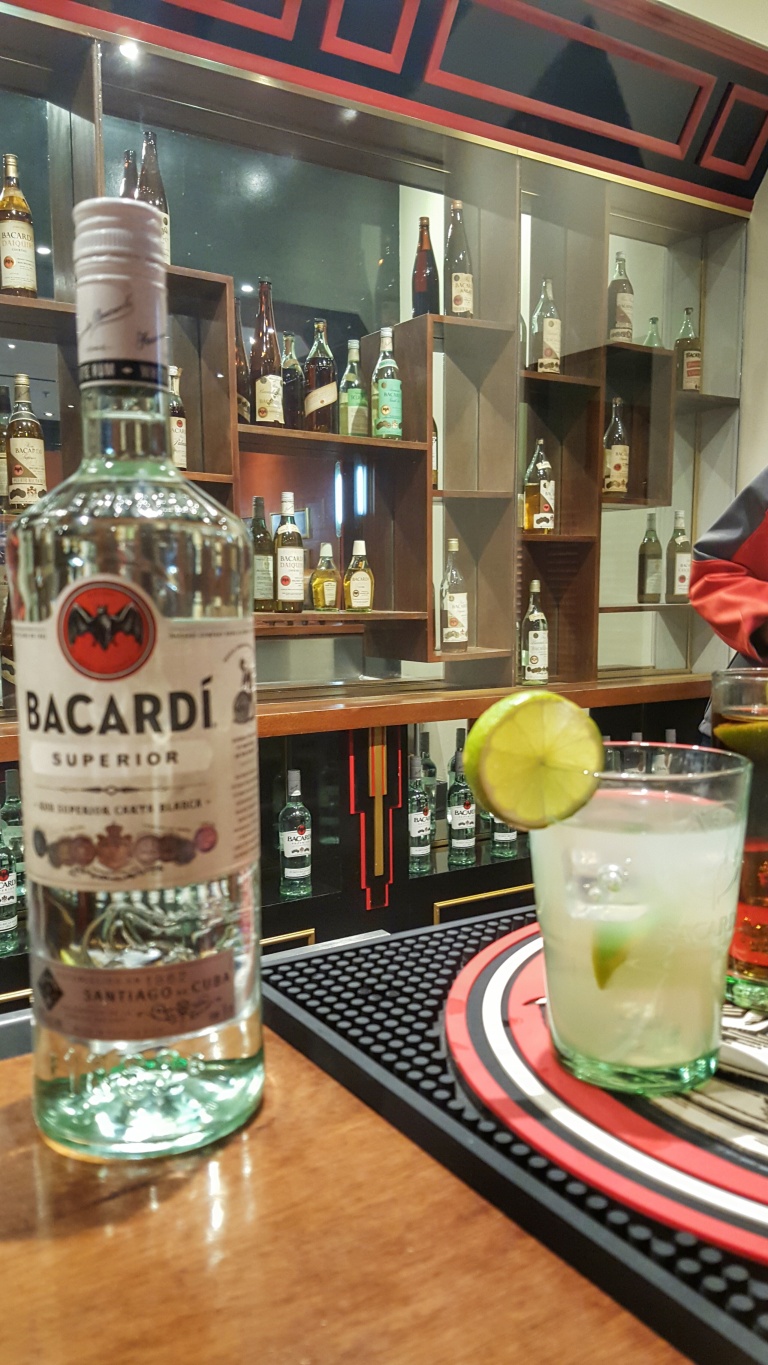
4. Some varieties of Bacardí are only available in Puerto Rico though…
Despite the rum being bottled in Jacksonville, there are two specialty types of Barcardí that are only available to buy in Puerto Rico (at either the gift shop at the Bacardí distillery or at the Bacardí shop at San Juan airport).
On the tour I got to sample Bacardí Reserva Limitada, which is aged in lightly charred American white oak barrels for ten to sixteen years. The resulting rum is a deep reddish gold colour, which has a rich, smooth taste with hints of vanilla, oak and dried fruit. It’s very, very strong.
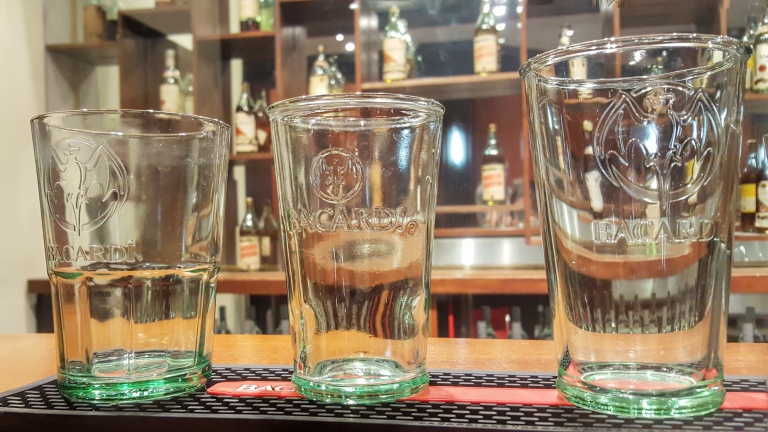
5. But every bottle features the Bacardí bat logo…
For some reason (and I think it’s because I once saw it on an episode of QI) I always thought the Bacardí logo was a bat because the company uses bat droppings in the distillation process. How wrong I was.
The truth is a lot less squeamish: the bat was used because there were bats hanging from the tin-roof distillery in Santiago de Cuba, when Bacardí first set up the business in 1862.
Apparently the bat has always been a symbol of good fortune in Catalan folklore, so when Doña Amalia Bacardí, Facundo Bacardí Massó’s wife, spotted fruit bats in the family’s distillery, she insisted it be used as their symbol. Soon the revolutionary, smooth-bodied rum became known as “the rum of the bat.”
Today the bat is still on the bottle, helping the family survive whatever fate throws at it.

6. The Bacardí business has been in the family for seven generations.
Since its humble begins in 1862, the Bacardí business has stayed in the family, being passed down from generation to generation. The company employs over 6,000 people around the work, manufactures at 27 facilities in 16 markets on four continents, with sales in more than 160 countries.
The Bacardí Limited headquarters are no longer in Cuba, but instead in Hamilton, Bermuda. And the company has a 16-member board of directors, led by the original founder’s great-great grandson, Facundo L. Bacardí.
The information centre at the distillery in Cataño is full of original artifacts, that provide insight into the history of the company.

7. …and the family holds the secret to the great taste of Bacardí rum.
When Facundo Bacardí Massó first came to Cuba in 1830, the locals already drank a primitive form of rum, “Aguardiente”, or “fire water” as it translates. It was cheap and unrefined, and rarely sold in upmarket taverns. So Facundo Bacardí Massó attempted to “tame” rum, by isolating a proprietary strain of yeast – one that is still used in Bacardí production today. This yeast gives Bacardí rum its flavour profile.
After experimenting with several techniques, Facundo Bacardí Massó found that filtering the rum through charcoal, removed the impurities. In addition he aged the rum in white oak barrels, which had the effect of mellowing the drink. The final product was the first clear, or “white” rum in the world.
I found out on the tour that standard charcoal filters are used for all rums, but that coconut shell charcoal is used for gold rum. Classy.
8. Did you know that Bacardí is aged in ex-Jack Daniels barrels?
Bacardí was the first rum maker to pioneer these particular methods.
Founder Facundo Bacardí Massó spent a great deal of time testing the interaction of wood with spirits. At that time, most spirits were shipped in whatever kind of barrel was available (used cognac casks, wine barrels, and barrels made from a wide range of woods). It was through trial and error that he discovered that aging rum in American white oak barrels produced the best results, ultimately setting the standard for aged rum in the world.
The tour guide then told us that the barrels Bacardí buys in are actually ex-Jack Daniel’s barrels, used for maturing its bourbon. Unlike other spirit producers, Jack Daniel’s uses its barrels just once. So not only is Bacardí making great rum, it’s also being environmentally friendly, as it uses the barrels over and over.
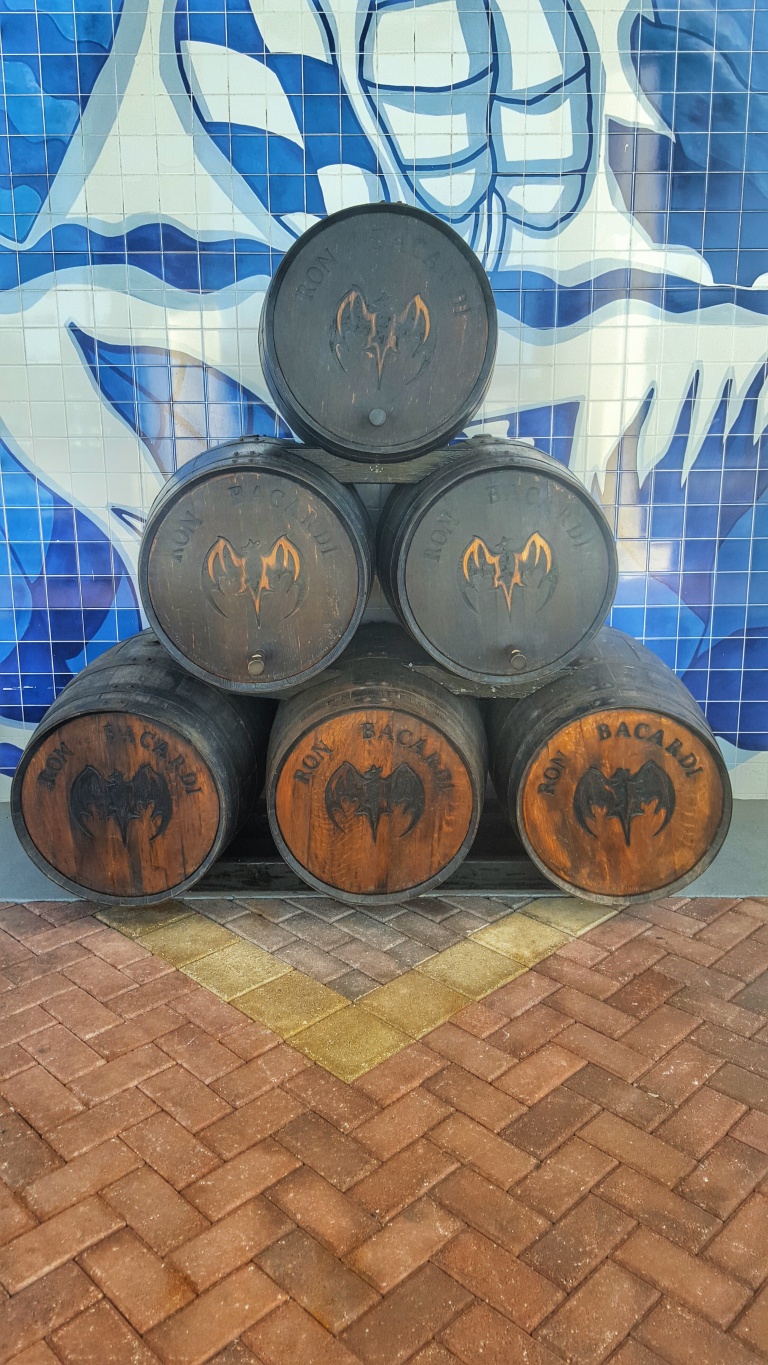
9. Even more green points, Bacardí’s distillery is powered by a huge windfarm.
Not only is Bacardí’s Cataño distillery the world’s biggest, it’s also the greenest. The company inaugurated a 500kW wind farm in April 2010, to power its rum production with renewable energy. It was the first industrial scale wind farm in Puerto Rico, and the biggest on the island at the time of opening.
Look how pretty the 100ft turbines are (I have this thing for windfarms):
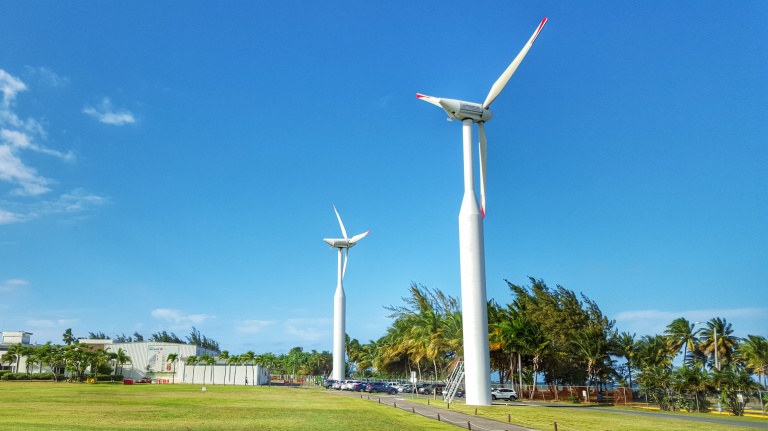
So there you have it – everything you ever needed to know about Bacardí and rum production in Puerto Rico.
Bet you fancy a Mojito now, I know I do.

I Like your pictures. They are full of fun. Thank you, for reading and likely my blog. It is greatly appreciated! 🙂
LikeLiked by 1 person
Thanks a lot Cheryl! x
LikeLike
This post is amazing!! Loving all the piccys to. thanks for sharing this one 🙂 Have a lovely day 🙂 x
LikeLiked by 1 person
Thanksssss x
LikeLiked by 1 person
I definitely fancy a mojito now I’ve read this! It looks like an amazing place x
LikeLiked by 1 person
Mojitos are sooooo good 😉 x
LikeLike
What a great post, sounds like a great place to visit, I can not drink bacardi as I get a hangover headache straight away, but can drink it in cocktails x
LikeLiked by 1 person
The cocktails were the best part about this trip 😉 the free samples of Bacardi were a little strong for me, I have to admit x
LikeLike
im so looking forward to the summer drinking fun in the hot tub in the garden , no worry baout school runs or work just refreshing fun and fresh air with nice cocotails , i need to try something new x
LikeLiked by 1 person
Ooooh that sounds fabulous! Hope you’ve managed to get some hot tub cocktails in x
LikeLike
You certainly learned a lot about the history of Bacardi, the family and the rum, during this tour. This tour would be interesting even for like me who are not drinkers, as there is so much information about how the Bacardi family started and grew the business and the history of rum.
LikeLiked by 1 person
Oh yes, completely – my mum doesn’t drink, and she still really enjoyed the tour! ☺️
LikeLike
I had no clue Bacardi was aged in old jack daniels barrels! I love rum but had to cut back on drinking it because of all of the sugar!
LikeLiked by 1 person
I had no idea either, that was definitely the best thing I learnt on the tour!!
LikeLike
I had no idea that Barcadi had been around so long or its ancestral roots either. I do love a pina colada!
LikeLiked by 1 person
Can’t help but start humming that song whenever someone says “Pina Colada” 😛 x
LikeLike
I really enjoy rum and would love to go go the distillery – i had no idea that bacardi had been around so long either! x
LikeLiked by 1 person
It’s a really interesting place to visit, the free cocktails are just a bonus 😉 x
LikeLike
This sounds like my kind of tour, I do love some rum x
LikeLiked by 1 person
If you’re ever in Puerto Rico Rhian, definitely pay the distillery a visit! x
LikeLike
I’d absolutely love to visit here one day. It looks so lovely!
LikeLiked by 1 person
Let’s go Ashleigh – I could do with some Mojitos right about now! x
LikeLike
This does sound like a great tour. I didn’t know Barcardi had been around for that long. I love Pina Coladas too!!!!!
LikeLiked by 1 person
I don’t think anyone can turn down a Pina Colada, especially when they’re “free” 😉
LikeLike
I would love to visit Puerto Rico one day. I adore rum! I love barcadi and coke. I think I was pirate in my past life. xx
LikeLiked by 1 person
Hehehe! You’re the same as me then Anna! x
LikeLike
Wow there’s certainly a lot of history behind Bacardi! I would love to visit Puerto Rico 🙂
LikeLiked by 1 person
There really is – I learnt so much on this tour! x
LikeLike
Never been to Puerto Rico but what an amazing trip and I havent had Barcadi in years x
LikeLiked by 1 person
I love a good Bacardi and coke 😉 x
LikeLike
Sounds a good place to visit, I haven’t been in Puerto Rico but I would love to go there someday.
LikeLiked by 1 person
If you get the chance you should definitely go – it’s a beautiful country x
LikeLike
This looks great! I love rum, especially if it’s in a mojito!
LikeLiked by 1 person
Me too! xx
LikeLike
45,000 cases of rum every day, that’s a crazy amount! Interesting facts, thanks for posting!
LikeLiked by 1 person
I know!! We’re obviously a globe of rum drinkers 😂👍🏻
LikeLike
Pina coladas are absolutely my favourite! I have friends who have taken this tour and I can’t wait to go, but honestly your post has made me even more eager.
LikeLiked by 1 person
Ahhh really – what did your friends think about the tour when they went? I absolutely loved it x
LikeLike
Great blog post. I never knew that’s where pina coladas came from or why Bacardi had a bat logo! I’m hoping those things will come up in a pub quiz soon so I can wow everyone that I know the answer!
LikeLiked by 1 person
Haha! I love a good pub quiz, so like learning useless trivia like this! X
LikeLiked by 1 person
I absolutely loved reading this post! I have loved Bacardi for years and never knew so many things about it, If I ever get to Puerto Rico I will definitely schedule in a visit here as it looks amazing x
LikeLiked by 1 person
You should 100% take the tour if you ever go to Puerto Rico x
LikeLike
This sounds like such a fantastic trip! I absolutly love Pina Coladas! xo
LikeLiked by 1 person
Who doesn’t?! 😛 x
LikeLike
this was such a fun but full of information post, i would have never know about the bacardi family!!!
LikeLiked by 1 person
I had no idea either until I went on the tour – I learnt so much about Bacardi x
LikeLike
OOh so many fab facts. I love rum in cocktails.
LikeLiked by 1 person
Me toooooo! And it was such an interesting place to learn facts about Bacardi x
LikeLike
This is so cool! I’m not a rum drinker, but would definitely go on this tour if I was ever in Puerto Rico. Your photos are fab too. 🙂
Ashton xx
LikeLiked by 1 person
Thanks Hun – my mum doesn’t drink either, but she really enjoyed the trip x
LikeLike
I had no idea that Barcardi was so old! Nor that they age it in Jack Daniels barrels! I love a distillery tour and this looked like lots of fun 🙂
LikeLiked by 1 person
I had no idea either, I learnt so much on this tour! x
LikeLike
This sounds like such a great place to visit. I don’t drink, myself, but I know lots of family members would adore a day out like this 🙂
Louise x
LikeLiked by 1 person
I think even if you’re teetotal this place is an interesting day out – I learnt so much about the company while there x
LikeLike
Do you know I don’t think I’ve even tasted Rum, let alone buy a glass. But having read your post I’m now intrigued so I’ve made a mental to order one next time I’m out!
LikeLiked by 1 person
You should definitely try one – mixed in a cocktail preferably 😉 x
LikeLiked by 1 person
My favourite spirit! It was what i first got drunk on on my first holiday abroad to tenerife age 18 – oh the joys! lol
LikeLiked by 1 person
Hahahaa I love this, I think Bacardi was the first thing I drunk too – Bacardi and coke flavoured Bacardi Breezers, remember those sickly sweet bottles of sugar?! 😉 X
LikeLike
Lovely post. I love rum and Bacardi is my favourite, yum!!
LikeLiked by 1 person
Mine too xx
LikeLike
I’ve never had a mojito but it’s on my bucket list over on my blog 🙂 I used to drink bacardi but am now more of a wine drinker
LikeLiked by 1 person
Definitely need to try a Mojito hun, they’re delicious! x
LikeLike
THIS LOOKS FASCINATING I WOULD LOVE A TOUR AROUND THE BACARDI FACTORY, HOW FASCINATING
LikeLiked by 1 person
It’s a really interesting place Kara – if you’re ever in Puerto Rico you should definitely add this to your “must do” list x
LikeLike
Love mojitos we make them all the time both with white rum and the spiced rum. Can’t drink it unless it’s in a cocktail though – no rum and coke in This house
LikeLiked by 1 person
Ooooh I love spiced rum – especially Captain Morgans! Mixed with a coke it tastes like cream soda 🙂 x
LikeLiked by 1 person
Love your pictures, there gorgeous. I’m not a fan of alcohol, but my godmother tells me I just haven’t found something I like yet. Haha never had a moijto maybe I need to try that. x
LikeLiked by 1 person
I’m with your godmother – try a teeny weeny mojito or Cuba Libre and see how you fare 😉 I love them! X
LikeLike
Used to love Bacardi, not had it in years. I never heard about the bat poo in the distillation process before, glad it’s not true.
LikeLiked by 1 person
Yeah, me too! Hahaha! X
LikeLike
What a dream vacation! Visiting the Bacardi spot is like going to a rare concert! super cool!
LikeLiked by 1 person
It was a fun afternoon!
LikeLike
Drinking rum in Puerto Rico sounds like an amazing experience. I have yet to get that far east in my travels!
LikeLiked by 1 person
When in the Caribbean, drink rum 😉 I hope you make it to that part of the world one day Heather! x
LikeLike
Puerto Rico looks amazing and would be a great place to touchdown especially for Rum lovers.
LikeLiked by 1 person
It really is the place to go if you like rum! x
LikeLike
Sounds fun! I once visited a rum distillery in Cuba 🙂 But hey, Germany also has wine. Quite good one actually, Riesling 🙂
LikeLiked by 1 person
I don’t think I’ve ever drunk Riesling, but then wine isn’t really my thing unless it’s in a restaurant with a big meal x
LikeLike
Looks amazing, sounds amazing, I would love it!
LikeLiked by 1 person
Get yourself over to Puerto Rico, it’s a great tour to take x
LikeLike
Awesome! thanks for sharing the behind the scenes of the brand & distillery! Its always fascinating to see what goes into creating something we aren’t familiar with! hope there was plenty of samples : )
LikeLiked by 1 person
I got double the amount of samples, as my mum doesn’t drink rum 😉 x
LikeLiked by 1 person
Mojito is the bestttt! It’s so cool to know about Bacardi’s rum through your perspective. Keep sharing us these great experiences of yours!
LikeLiked by 1 person
Thanks so much Son Nguyen! I appreciate your comment 🙂 x
LikeLike
I don’t drink much, once or twice every few years but when I do, it’s Jack that I like. A nice shot here or there is good. I’ve never had Bacardi.
LikeLiked by 1 person
Maybe you should broaden your tastes and try Barcardi some time? I really like it x
LikeLike
This trip to bacardi must have been exciting.. I love visiting brewery, though
LikeLiked by 1 person
Really, have you visited any other breweries/distilleries? x
LikeLike
I’ve never been huge on rum. I mean, I’d drink it if it’s given to me but I wouldn’t choose it.
LikeLiked by 1 person
I think even if you don’t drink rum, this tour is still interesting as you learn loads of history about the brand and about the island x
LikeLike
Bacardi is probably my favorite rum. Maybe it’s because I’m half Cuban. My family claims to have known the Bacardis but who knows if it’s true?
LikeLiked by 1 person
Wow, half Cuban AND family ties to the Bacardis… that’s so cool! x
LikeLiked by 1 person
Unconfirmed family ties 😉
LikeLiked by 1 person
Oh man I have been wanting to take a trip to PR. Looks like you had a great time with Barcadi.
LikeLiked by 1 person
It was a great tour of the distillery and we learnt a lot! x
LikeLike
Very cool. Puerto Rico is a great destination. I hope to go one day. It is just beautiful. Bacardi limon.
LikeLiked by 1 person
Fingers crossed you make it there one day Lisa! x
LikeLike
Love myself a bit of bacardi. Not too much tho. Drink driving is frowned upon. Great article a lot of information i didnt know before. Thanks for sharing
LikeLiked by 1 person
Drink driving is definitely frowned upon – and it’s stupid too! x
LikeLike
If I have a regret, it’s not having made it to the the distillery when I went there in October last year. Now I feel like I need to redo of my trip all over.
LikeLiked by 1 person
That looks and sounds like quite a fun trip! Lots of relaxing and lots of RUM! ha!
LikeLiked by 1 person
There wasn’t much relaxing, I have to say – but certainly a fair bit of rum! x
LikeLike
Bacardi and coke was my go to drink years ago, but I had always assumed it was just made in a regular factory in the US. Great to know it is so authentic and produced in such a great place. Love that they use wind power too.
LikeLiked by 1 person
Yes, the wind power thing really got me too – it’s great to see such a big brand (who is obviously going to be using A LOT of energy) trying to be a bit greener x
LikeLike
Never been to Puerto Rico, but hope to soon! Maybe it’ll be our 51st state when we do!
LikeLiked by 1 person
Perhaps! It’s a great island to visit! x
LikeLike
Great photos and a very interesting text! I’d like to taste this beverage! 🙂
LikeLiked by 1 person
If you haven’t tried Bacardi already, you really should! x
LikeLike
Rum is my favor liquor. I can’t believe I missed this when I was in Puerto Rico!
LikeLiked by 1 person
You’ll just have to visit Puerto Rico again hehe 😉 x
LikeLike
I didn’t know that Puerto Rico was the rum capital of the world. Rum is something I enjoy once in a while. Bacardi distillery tour sounds like it would be really interesting and I would love to do this some day. Thanks for sharing the information and your experiences.
LikeLiked by 1 person
I hope you get to experience it at some point Rebecca 🙂 x
LikeLike
Eventhough l dont drink liquor you made it look delicious.
LikeLiked by 1 person
Thanks
LikeLike